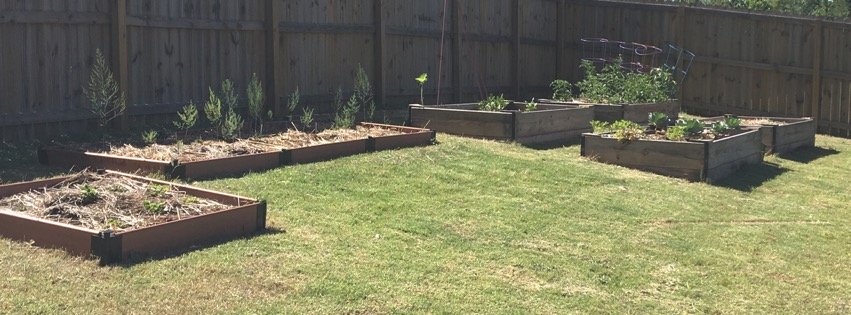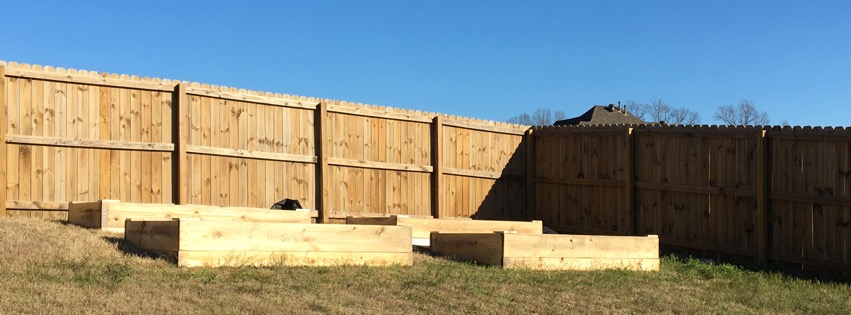Vegetable Gardening Basics
for
Vegetable Gardening Success
The following vegetable gardening basics will lay the foundation for a successful garden.
You need a sunny spot with access to a water source and you need healthy soil topped with mulch. With these four ingredients you will be on your way to having a successful garden year after year.
 My garden...Spring 2017
My garden...Spring 2017The Basic Need for Sunshine
Do you have a spot in your yard that gets plenty of sunshine? Sunshine is a primary vegetable garden basic and your plants will need at least 6 hours of sun each day.
Some people say pick a spot close to the house, but my garden is up on a sunny hill at the back of my yard. The choice is up to you. If having the garden close to the house will keep you motivated to tend to your garden, you can't go wrong. If you are like me, you may enjoy walking out to the garden each morning.
Garden Layout
You've picked the best spot for your garden. Now it is time to decide where you will put your planting areas and where your paths will be. Measure your space and draw your plan out on paper. Planting areas should be no more than 3 or 4 feet across. This will allow you to reach everything planted without stepping on your garden soil.
Do you want to contain your planting area by building raised beds? Or would you like a more free form garden where the paths surround your planting areas?
Dream Big, Start Small
 Newly built raised vegetable garden beds.
Newly built raised vegetable garden beds.Since this is your first year with a garden, I'm going to suggest that you dream big on your paper plans but start small. For instance, I have plans for a total of 10 raised garden beds, but I started with 4. Even though I've been gardening for 16 years, I moved last year so I will add to my new garden little by little. Get your vegetable gardening basics in place on a time schedule that works best for you and then continue to expand as you have the time.
The basic need for healthy soil
I'm going to tell you how to build the foundation for this vegetable garden basic over your existing yard.
- To get ready for this step, mow your yard at the lowest setting. If you haven't used chemicals on your yard, you can save the grass clippings as we can use these later.
- Build your raised beds or mark off your planting areas.
- Place a thick layer of newspaper in your beds. (You can also do this to your paths. Putting mulch on top of the newspaper will make nice paths and keep grass from growing through.)
- Soak the newspaper. This will kill off any grass underneath as it decomposes.
- Now place a layer of cardboard over the newspaper. This can be as thick as you like. I used our moving boxes so this layer was pretty thick for me.
- Now you will start layering organic matter over the cardboard. This can be anything that will break down. Some ideas are: grass clippings, leaves, hay, aged manure, etc.
Your next step will depend on the season. If you are planting right away, you can buy organic garden soil from your local nursery or garden store to put as a top layer on your garden beds. If it is late in the year, you can let them sit for the winter and they will be ready for planting in the spring.
The basic need for mulch
Do you want to use less water and have less weeds?
Okay! As far as vegetable gardening basics go, mulch is not necessarily one of them. You could get by without it but that would mean more work so it would be a disservice if I didn't include it here. Covering the soil with mulch retains moisture and blocks out weeds. I have used grass clippings, hay, straw, pine needles, and leaves to mulch my garden. Wood chips are also a good choice.
Some people worry about weeds sprouting up when using grass or hay but this has never been a problem for me. If I have a weed or grass grow, I cover it with more mulch or pull it up. In my first garden, I had an endless supply of mowed weeds which I placed around my vegetable plants. I'm sure it was full of seeds but this never caused a problem and my plants were always very happy.
The basic need for water
When it comes to vegetable gardening basics, we can forget water. Gardens need at least one inch of water a week. It is best to water once per week once your plants are established rather than a little every few days. I keep a reminder on my phone to water every 7 days and if we have a rain, I move it 7 days out.
A flowmeter is a helpful tool which will measure the amount of water coming from your spigot. This can save you money if you are in a dry area and have to water your garden often.
Vegetable Gardening Basics: CHECK!
You have taken care of the vegetable gardening basics. Now you are ready to have a successful garden with plenty of vegetables to eat and share.
Now you are ready to learn about planning your garden, growing vegetables from seed, easy to grow vegetables.
> Vegetable Gardening > Getting Started